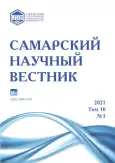Interrelation of hydrochemical indicators and the microbial community structure in the rivers within oil fields of the Khanty-Mansi Autonomous Okrug – Yugra
- Authors: Arslanova M.M.1, Shornikova E.A.1
-
Affiliations:
- Surgut State University
- Issue: Vol 10, No 1 (2021)
- Pages: 20-23
- Section: General Biology
- URL: https://journals.rcsi.science/2309-4370/article/view/70274
- DOI: https://doi.org/10.17816/snv2021101102
- ID: 70274
Cite item
Full Text
Abstract
Assessing the quality of environmental objects, identifying the causes of pollution and predicting the future state is an urgent and important task, since it is the quality of natural objects that largely determines the state of human health. This paper presents results of the statistical analysis of the data of water quality monitoring in the rivers within oil fields of the Khanty-Mansi Autonomous Okrug – Yugra during 2018–2019. The correlation analysis (according to Pearson) was carried out to identify the relationships between the samples of hydrochemical parameters and the number of microorganisms of various ecological-trophic groups. As a result of the correlation analysis of the relationship between the indicators of the chemical composition of water, a direct and inverse correlation was obtained for the following indicators: total iron, anionic surfactants, nickel, phenols, copper, sulfates, ammonium ions, lead, phosphates, manganese. The maximum value of the correlation coefficient is observed for Ni and Cr concentrations. For total iron and manganese, a significant positive correlation is also revealed. The distribution of chemical compounds in the rivers doesn’t have a pronounced correlation dependence, which is probably due to the heterogeneity of the composition of the waters, as well as to the increasing impact on the environment of the oil and gas complex.
Full Text
##article.viewOnOriginalSite##About the authors
Marina Magomedovna Arslanova
Surgut State University
Author for correspondence.
Email: marina.arslanova.93@mail.ru
postgraduate student of Ecology and Biophysics Department
Russian Federation, Surgut, Khanty-Mansi Autonomous Okrug – YugraElena Aleksandrovna Shornikova
Surgut State University
Email: capucin72@mail.ru
candidate of biological sciences, associate professor of Ecology and Biophysics Department
Russian Federation, Surgut, Khanty-Mansi Autonomous Okrug – YugraReferences
- Московченко Д.В. Эколого-геохимическое состояние водных объектов на территории заказника «Сургутский» // Вестник экологии, лесоведения и ландшафтоведения. 2007. № 7. С. 163–171.
- Шорникова Е.А. Диагностика состояния экосистем водотоков на лицензионных участках нефтяных месторождений Среднего Приобья // Электронный научный журнал «Нефтегазовое дело». 2007. № 1. С. 34.
- Хорошавин В.Ю. Техногенная трансформация гидрологического режима и качества вод малых рек в пределах нефтегазовых месторождений бассейна Пура: автореф. дис. … канд. геогр. наук. Тюмень, 2005. 230 с.
- Справочник по свойствам, методам анализа и очистке воды: в 2 ч. Ч. 1. К.: Наукова думка, 1980. 680 с.
- Шварцев С.Л. Гидрогеохимия зоны гипергенеза. М.: Недра, 1978. 287 с.
- Шорникова Е.А. Методические рекомендации по планированию, организации и ведению мониторинга поверхностных водотоков: гидрохимические и микробиологические методы. Сургут: Дефис, 2007. 88 с.
- Афанасьев Ю.А., Фомин С.А., Меньшиков В.В. и др. Мониторинг и методы контроля окружающей среды: учеб. пособие в 2-х частях: В 2 ч. М.: Изд-во МНЭПУ, 2001. 337 с.
- Руководство по методам гидробиологического анализа поверхностных вод и донных отложений / под ред. В.А. Абакумова. Л.: Гидрометиоиздат, 1983. 218 с.
- Билай В.И., Коваль Э.З. Аспергиллы. Определитель // Академия наук Украинской ССР. Институт микробиологии и вирусологии им. Д.К. Заволотного. Киев: Наукова Думка, 1988. 204 с.
- Определитель бактерий Берджи. В 2-х т. Т. 2 / под ред. Дж. Хоулта, Н. Крига, П. Снита, Дж. Стейли, С. Уильямса. М.: Мир, 1997. 432 с.
- Определитель бактерий Берджи. В 2-х т. Т. 1 / под ред. Дж. Хоулта, Н. Крига, П. Снита, Дж. Стейли, С. Уильямса. М.: Мир, 1997. 368 с.
- Борздова Т.В. Основы статистического анализа и обработка данных с применением Мicrosoft Ехсеl: учеб. пособие. Минск: ГИУСТ БГУ, 2011. 75 с.
- Овчинникова Т.А., Прохорова Н.В., Панкратов Т.А. Некоторые микробиологические особенности почвенного покрова города Новокуйбышевска в осенний период // Самарская Лука: проблемы региональной и глобальной экологии. 2010. Т. 19, № 2. С. 83–91.
Supplementary files








